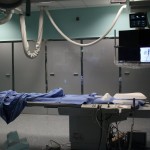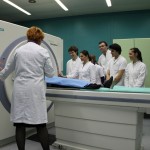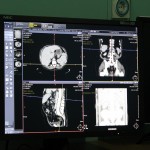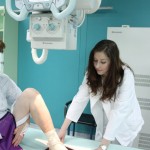Study curriculum | Accreditation [PDF]
Rationale
An radiological technologist is a professional with higher level education who is trained to work in medicine, dental medicine, and veterinary medicine. The professional scope of activity includes three special medical branches: a) diagnostic and intervention radiology; b) radiotherapy and oncology; and c) nuclear medicine. The radiological technologist performs her/his duties and tasks within these three medical specialties, as well as those concerned with the diagnosis, intervention and therapy.
Most of radiological technologist get employed in radiology departments and are engaged in diagnostic procedures (90%), which reflects the contents of the here presented study program. As the activities are in the most part of practical nature, the study program is designed to have 50% of curricula with practical contents, i.e. demonstration classes and clinical practice.
The purpose of study program is to satisfy the needs of public and private health institutions. Medical, dental and veterinary diagnostic services can hardly exist without the use of procedures employing open and closed sources of ionising radiation, ultrasound and magnetic resonance. Therapeutic procedures employing closed sources radiation and radiation with radioactive isotopes is an imperative in the treatment of malignant diseases in humans. None of these methods can be used without participation of radiological technologist in the working process.
Radiology, radiotherapy and nuclear medicine, both technologically and methodologically, are considered highly propulsive disciplines characterised by continuous progress and innovations. Almost every 10 years significant shifts take place resulting in the replacement of old methods by the new ones. The techniques of analogue imaging, manually conducted procedures, traditional presentation of data, and the like, are continually being replaced by digital procedures and high automatization of diagnostic and therapeutic procedures.
The three medical branches include many modern methods that need to be carefully managed and supervised, while a faultless communication with the patient and the physician specialist is a must. In order to competently perform on such a complex job, an radiological technologist should be educated at higher level and properly trained in practical procedures.
Radiology is a diagnostic medical specialty that entered medical profession in 1896. A systematic education of radiologists and their radiographic assistants, precursors of today’s radiological technologist, has been carried out for more than 70 years. Today there is probably no European country in which this profile of medical professional is educated. Some countries have a 3-year academic study program, some have modular type of training with limited competences for different levels of knowledge and skills. In Croatia a formal regular education started 50 years ago.
In accordance with Bologna Declaration and EHEA doctrine intentions and objectives, our study program has been harmonised on a national level and is compatible with similar study programs carried out at Rijeka and Split university medical schools. Thus the vertical and horizontal mobility of students is enabled within the national academic space of the same professional and educational levels.
The contents of the study program are entirely compatible with the similar study programs in EU countries. While in the United Kingdom and the USA modular and multi-degree system of education is often employed, in the majority of European countries and also in Croatia, which is a rather small labour market, a unique study system is a method of choice that ensures complete competence in performing a professional job. When considering the number of study curricula and extent of education field of interest our study program is almost equal to similar European study programs.
With regard to the number of teaching hours (2745), our program is compatible with the one in the Czech Republic (2956 teaching hours) and Slovenia (2322 teaching hours); these are the countries that have similar study programs in higher level education for medical professions. When adding a one-year obligatory internship in health institutions, which in Croatia ends by passing a State-Board Examination, and which in Austria and Germany is only part of the study program, then the Croatian study program is also comparable with the Austrian (4605 teaching hours) and the German one (4400 teaching hours). (Data from 2005)
The study program and the existing optimal conditions for high quality practical classes in their full range, achieved through collaboration with top clinics and health institutions in Zagreb, ensure the satisfaction of health care system demands for health professionals of radiological technologist in Croatia. Naturally, the participation of the other two Croatian biomedical higher level education institutions providing similar study programs is included.
Getting closer to European educational standards makes it possible to become part of a wider educational and academic trends, and ensured conditions needed to meet the requirements of Bologna Declaration.
Current Experiences with Similar Programs
The tradition of formal education for radiology assistants is longer than 75 years and goes as far back as 1901, when the first x-ray device was installed in Zagreb; only five years following the historic lecture by W.C. Roentgen on x-rays.
In 1946 a formal secondary school program was established for radiographic technicians. In 1947 the secondary school for radiographic technicians was funded, while in 1958 the Advanced School for Radiological Technicians was established, with post secondary study program.
Since the establishment of the Advanced School of Nursing in Zagreb in 1966, the study program for radiological technicians became an autonomous School department. In 1986 the study was renamed the Department of Medical Radiology and has continued to be integral part of Zagreb University of Applied Studies.
The study program has always consisted of theoretical and practical classes and is closely connected with radiological institutions as education bases for practical and clinical classes. Theory was taught by distinguished radiologists employed in Zagreb clinical hospitals, while clinical practice was supervised by highly experienced radiological technologist, with long-term working and teaching experiences. Clinical practice was usually prolonged during summer months. Such a scheme has remained unchanged all until the present day. However, the need for greater participation of radiological technologist, physicists, computer professionals, communication experts, and professionals of other allied branches is being increasingly pointed out nowadays.
As it is an imperative for the profession to follow the advancement of science, in both structure and content, and having in mind the fact that radiology due to technological progress is advancing at a rapid rate, in 1999 the study program has been developed into a three-year academic program and many new study subjects have been introduced. Theoretical subjects are enriched by mandatory and elective subjects about the newly discovered areas, while practical classes have further been improved in both their form and contents.
The study program for 2005 is a continuation of previous tendencies to extent the areas of students’ interests and their knowledge and skills onto new professional fields of radiology, radiotherapy and nuclear medicine.
Students’ Mobility
The study program is organised as defined by the Act on Scientific Activities in Higher Education (July 2004) as a three-year professional pre-graduate study. By its structure it is compatible with the other two similar study programs in Croatia (Rijeka and Split university schools of medicine) and with many other similar studies in Europe with the same integral study program profile. In this way a horizontal and vertical mobility of students is made possible provided basic conditions are satisfied; for example, an agreement between the institutions of higher education (universities, colleges) in biomedical fields is reached and the universal ECTS scoring system recognized.
Students from other higher education institutions with health studies programs can be enrolled into the basic and specialistic study programs. The transfer of students to university studies is possible if the contents and number of teaching hours are corresponding.
General information
University of Applied Health Studies
Name of the Study
Professional study of radiological technology
Duration
Three (3) academic years (6 semesters)
Admission Conditions
Fully completed four-year secondary school program and entrance exam plus certificate that there are no contra-indications to perform the selected profession.
Students of similar study programs in biomedical fields can also be enrolled.
Competences of Graduate Students, Job Skills and Opportunity for Continuing Education
Competences of Graduate Students in Diagnostic Radiography
The radiological technologist is trained to independently perform the following activities or to work in a team with a radiologist:
Conventional and digital radiography, conventional imaging techniques with contrast media; fluoroscopy with target tissue radiographic imaging; conventional tomography; ERCP imaging; digital angiography – DSA; digital coronography and ventriculography – CDSA; fluoroscopy and fluorography with mobile radiographic equipment; mammography; CT: dynamic CT and CTA imaging; US and Doppler dynamic imaging; MR and MRA imaging; dental radiography.
Competences of Graduate Students in Intervention Radiography
The radiological technologist is trained to perform, as a team member, blood vessels PTA, embolotherapy and occlusive bandage procedures, blood vessel stent implantation procedures, trans-catheter application of cytostatics, fluoroscopically conducted cytological punctures and biopsies, ultrasonically conducted cytological punctures and biopsies, positioning of nephrostomy, drainage of cysts and abscesses.
Competences of Graduate Students in Radiotherapy and Oncology
The radiological technologist is trained to work with the devices and equipment like those used for tele-cobalt therapy, linear accelerator, superficial radiotherapy; she/he is trained to work with simulator and to prepare instruments and other equipment needed in the planning of radiotherapy; participates in the designing of radiotherapeutic masks, protective blocks, including lung blocks, making of casts for application of intra-cavitary (vaginal,) radiotherapy and percutaneous isotope therapy; designs splints for children to immobilise the extremities; makes boluses; marks the defined radiation fields during planning, makes tattoos of central and borderline points of the radiation field; notes the data about radiation into patient’s therapeutic protocols on a daily basis; checks and maintains radiation demarcation lines; talks with the patients about difficulties they might experience because radiation effects and refers them to discuss the problems with the physician; instructs the patients about how to prevent damages caused by radiation (superficial and other).
Competences of Graduate Students in Nuclear Medicine
The radiological technologist is trained to independently prepare radionuclides and to participate in the marking of radiopharmaceuticals, to separate individual doses (or activities) and to measure the activities by dose calibrators; she/he participates in taking a patient’s medical history, preparation of patients for image taking by gamma camera (in collaboration with a physician), putting the patients in proper position for gamma camera shooting; she/he independently operates NM devices in terms of setting the parameters, taking static, dynamic and SPECT digital images, controlling the process of image acquisition, analysis of quality and completeness of the obtained images, changing of collimator, processing and printing of the accepted NM image; her/his computer literacy level includes knowledge about the functioning of the systems in operation, computer applications (text analysis and tabular calculations), and specific NM programs for acquisition and analysis of digital NM images; participates in in-vitro measurements for which it is needed to how a series of scntillation counters and detectors operate; she/he prepares conditions for and participates in the carrying out of radionuclide therapy; ensures the working standards quality in NM units: by daily control of quality or individual engineer’s work (e.g. camera calibration- “peaking”, intrinsic or extrinsic assessment of visual field uniformity; annual, monthly or daily periodic quality control procedures for a number of measurement parameters); actively participates in the program of protection from ionising radiation of staff and patients through proper knowledge of protection principles, use of protective means, participation in optimisation of protection from radiation, and, as necessary, carrying out of decontamination measures.
Job Skills
The radiological technologist is trained to perform jobs and duties in radiology, radiotherapy and nuclear medicine within the scope of her/his competences. Depending on methodology and patient status, she/he acts independently or as a member of professional team with physician specialist, or as a member of a wider team of experts when complex and assisted procedures are performed.
Beside basic tasks of conducting diagnostic or therapeutic procedure, the radiological technologist cares about the safety of patients, organises diagnostic or therapeutic procedure, check technical and medical working conditions, keeps administration, co-ordinates procedures of different medical professionals included in radiographic activities.
She/he is trained to control and to meet the legal administrative and financial conditions, takes care of disposable materials, supervises equipment operation, supervises conditions for radiation sources to be used in a harmless fashion, and other.
Opportunity for Continuing Education
There is a possibility to continue education in specialist 1 to 2 year study programs on institutions of higher education of biomedical fields (college or university).
Specialistic courses are aimed at specific topics in medical radiography in order to revise and enhance knowledge and skills needed to competently perform the profession.
Professional Title
Baccalaureate in radiological technology (professional B.A.).









